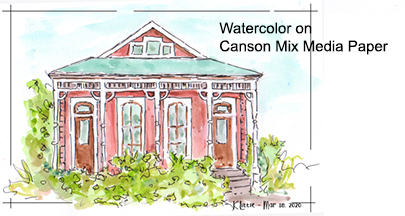Action Sketching: How to develop your unique artistic style
There are several skills you need to master when seeking to develop your own style. The first is actually drawing “the thing,” whatever it is you want to focus on. The next is determining what tools and medium to use. And the third, how to use them. This article focuses on how to use your tools in order to develop your own style.
Developing Your Style
It is important to be aware of numerous artistic styles and try many of them yourself in order to find the one you like best. While you can do this by drawing many pictures, testing techniques as you go, it is more efficient to try different styles on a single subject so you can more easily compare them and determine which ones you enjoy the most.
To get started, very lightly sketch a subject of your choice. Next, scan or photograph the sketch, then print numerous copies. Below is an example of a very light pencil sketch based on a photo I took of a Shotgun House in New Orleans.
With prints now at hand, finish each one in a different style, such as by cross-hatching, shading, pen work, or even coloring.
The following provides brief examples on how to proceed. The first, partially finished example was done with a micro Uni-Ball pen followed by a print partially finished using a BIC mechanical pencil.
Depending on the paper you use, you can also explore watercolors, acrylics, and even alcohol-based colored markers.
Develop ideas by studying other people’s drawings, then practice using their techniques. By trying numerous techniques on a single subject, you’ll identify which ones you more passionately like doing.
Paper:
The paper you choose is important. Paper with “tooth” is the best to use with a pencil, even inexpensive, mechanical pencils like BICs. The reason is that by repeatedly lightly rubbing over the same area leaves layers of graphite behind, thus developing increasingly dark shades. This cannot be done easily on printer paper, consequently, lines made on printer paper all appear gray, no matter how hard you press or many cross-hatchings you employ.
To save money, practice sketching on printer paper. As you explore new techniques, however, invest in papers more suitable to the tools you prefer using.
Multi-media paper can be used for pencil, pen, and some paints, but it doesn’t come in standard printer paper sizes. To easily solve the problem of transferring your basic sketch to it, without having to consult your printer’s measurement table, tape the multi-media sheet to printer paper, then hand-feed the “set” through your printer, making sure the tape is smoothly pressed down.
Links:
There are several online tutorials classified by medium (such as ink or pencil), technique (cross-hatching or shading), paint (watercolor or markers), and even “mixed medium” that combines many things.
- Cross-Hatching: What is Crosshatching? – Pen and ink drawing for beginners
- Shading: How to Shade with PENCIL for BEGINNERS
- Felt-tip markers: How to Shade With Markers : Drawing & Art
- Micron pens: Hand Lettering with Pigma Micron Pens
- Mixed Media Paper: Use this reasonably-priced paper for pen, pencil, or pencil. Strathmore and Canson both sell it by the pad, however, I prefer Canson’s spiral bound pads.
- Cheap Joe’s Art Stuff – Strathmore
- Cheap Joe’s Art Stuff – Canson
Author:
This article was written by Karen Little as part of an ongoing series of blogs on Action Sketching. Published on Littleviews.com. March 23, 2020.
Reproduction of this article is free to non-commercial websites (or other media) with permission and attributes to Littleviews.com and the article’s author.
All other material on Littleviews (with noted exceptions) is copyrighted on the date of publication or as noted in credits.
Questions? Ask Karen Little at Karen@littleviews.com.
Support Our Mission:
Products sold on Sketch-Views.com contain images exclusively created for Sketch-Views gift products by designer, Karen Little. Revenues support Littleviews’ mission to provide drawing tips and events.



